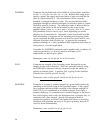
where level, R, G, and B are integers between 0 and 255, inclusive.
The level column represents the signal level, and R, G, and B are the
usual RGB colour components.
Choices of curve are linear, gamma, logarithmic, and MuLaw. The
linear curve spaces the palette entries out evenly, with the
maximum value in the picture being 255 and the minimum, 0. The
gamma curve first takes the square root of the absolute value of the
variable, restores the sign, and spaces out the result evenly. This
accentuates details in the weaker-field regions, without losing
definition in the higher-field regions. The logarithmic curve
accentuates weak fields very strongly, which is very useful in some
cases but tends to lose detail where the field is strong. The
mathematical logarithm is modified to avoid floating-point runtime
errors: it actually computes
where x has been normalized by the largest element in absolute
value. The MuLaw curve uses the CCITT µ-255 codec curve, which
is linear for values near the positive and negative limits, but puts
the levels close together near zero. While this resembles a bipolar
version of the logarithmic curve, it actually combines many of the
advantages of the linear and logarithmic curves, since not all detail
is lost at the highest values.
Syntax: SLICE file = <fname> xlo=<value> xhi=<value> ,
ylo=<value> yhi=<value> zlo=<value> zhi=<value> ,
phase=<value> variable = Ex
Example:
SLICE file = /var/tmp/v1aExIsourceZ.bmp xlo=0 xhi=xsize ,
ylo=0 yhi=ysize zlo=1.5*um zhi=1.5*um phase=0 ,
variable = Ex
3.1.10. OPTIMIZE Group
VARIABLES Tell the optimizer which variables to optimize over. These must
have been defined in a SET statement.
Syntax: VARIABLES var1 ... varN
GUESS Supplies a guess to the optimizer. A guess is a point in the N-
dimensional parameter space. For an N-dimensional optimization
run, N+1 guesses are required, each supplying all N variable values.
The first guess is supplied by the SET statements where the
optimization variables are defined, but additional ones can be
supplied by GUESS statements. If more than N+1 guesses are
28


















